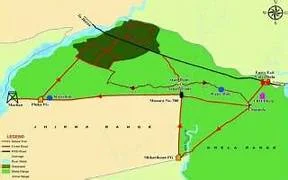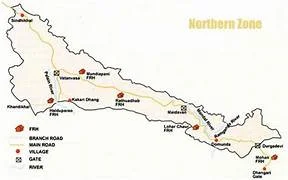This is not an official website of Corbett national park. It is registered under the private travel agency name Seven Safar Tour & Travels. We organize Hotel, Safari and Tour Package bookings in Corbett national park.
There are Eight Corbett Safari Zones: Dhikala Zone, Bijrani Zone, Jhirna Zone, Garjiya Zone, Sitabani Zone, Phato Zone, Dhela Zone, and Durga Devi Zone. Each zone offers unique attractions and sights to explore.
Safari tours are organized in two shifts by the forest officials of Corbett Tiger Reserve in each of these ecotourism zones. A limited number of safari jeeps are allowed in every zone to ensure the proper distribution of tourist flow. Each zone boasts its natural charm, with specific landscape beauty and wildlife. While tiger sightings are possible in every zone, there may be slight differences in topography as all the zones are part of the same geographical area.

Bijrani Zone is popular among day tourists visiting Jim Corbett National Park. Located about 1 km from Ramnagar, its entrance at Aamdanda begins an exciting jungle safari experience. Upon entering through the Aamdanda gate, visitors traverse approximately 5 km of the buffer zone before reaching Bijrani, where the jungle safari officially commences. Bijrani Jeep Safari in Jim Corbett National Park (Corbett Tiger Reserve), Uttarakhand, India, allows visitors to explore the park's diverse landscapes and wildlife. Known for its vast grasslands, dense forests, meandering streams, and remarkable wildlife, Bijrani is a beautiful and captivating area within the reserve. To visit Bijrani, permission must be obtained from the Director of Corbett Tiger Reserve. Each day, 30 vehicles are permitted to enter Bijrani for morning and evening safaris. Booking is required for morning safaris, while permits for evening safaris are issued on a first-come, first-served basis. Bijrani also features a forest lodge with six rooms and a dormitory accommodating four beds, providing comfortable accommodation options for visitors. Additionally, elephant safaris are available for those seeking a unique and immersive wildlife experience in the Bijrani Zone of Jim Corbett National Park.

Dhikala Safari Zone is famous for its diverse wildlife, dense forests, and jeep safaris. To visit the Dhikala Zone, you need to book in advance. Booking can be made from the official website or the authorized tour provider. You can also check our page to book Dhikala Safari Zone. Visitors can book safaris for either the morning or evening, with options available for half-day or full-day. Dhikala Forest Rest House is one of the most extensive tourist zones in Corbett National Park. Dhangarhi Gate is 22 km from the forest rest house, and Dhikala Zone is 300 km from Delhi.
Furthermore, from Ramnagar, Dhikala Zone is 50 km away. All the rooms in Dhikala have attached bathrooms with hot and cold water available. Dhikala is always overcrowded, so make sure to book it in advance. When booking accommodation, you must hire a Safari Jeep to visit the Forest Rest House (FRH). Jeep Safari is the best way to explore Corbett's picturesque forest and observe wild animals in their natural habitat. Unlike other zones in Corbett National Park, day visitors cannot access Jeep safaris in the Dhikala tourism zone. However, if you obtain a permit for an overnight stay in one of the forest houses in the Dhikala zone, you can use the Jeep Safari facility.

The Jhirna zone, situated in the southern part of Corbett National Park, is renowned for its excellent wildlife viewing opportunities and is accessible to visitors throughout the year. This area, once a village relocated to make way for Project Tiger, has now transformed into a dense forest. The entry point to the Jhirna Safari zone is the Dhela Gate, 15 km from Ramnagar.

Regarding Corbett Jungle Safari, the Dhela tourism zone had the highest tiger spotting rate after the Dhikala zone during 2019-20. The demand for Jeep safaris in Dhela is consistently high, with many sightings of tigers near the entry gate, indicating a high tiger density. The Dhela Zone boasts rich flora and fauna, with mixed Sal, Rohini, Haldu, Bahera, and Kusum forests. Wildlife includes tigers, leopards, Asian elephants, sloth bears, and king cobras. Known for its bird diversity, Dhela offers Jeep safaris in morning and evening shifts, with only 15 vehicles allowed per shift. The zone is open year-round and is especially popular for bird watching. Also, it is just 15 km away from Ramnagar.

One of the park's six ecotourism zones, this area is renowned for its abundant population of exotic birds, making it a paradise for bird lovers. In addition to its avian richness, the zone boasts a diverse array of wild animals, attracting numerous tourists annually. Accessible through the Durgadevi gate, located 30 km from the nearest city of Ramnagar. Likewise, this zone is the most distant from civilization, enhancing its peaceful wilderness allure. Accommodation options include the Lohachaur forest rest house, allowing visitors to engage in the dense forest environment. Tourists must acquire permits for entry into the park to experience day Jeep safaris or overnight stays at the rest house.

The Garjiya jungle area of the Jim Corbett National Park is a popular destination for its beautiful landscape. This beautiful zone is located at a distance of 5 km from the city of Ramnagar. The entry gate to the Garjiya zone is the Ringora gate, which is about 1.1 km away from the city of Ramnagar. After entering through the Ringora gate, Garjiya competes with Dhikala regarding tourist zones. Visitors come to this region for its beautiful landscape. It's quiet and peaceful, with dense forests and breathtaking natural beauty. This is also the most tiger-populated zone in Corbett National Park.
The tourists can also take Jeep Safari. Both services are available in the Sanctuary. Booking in advance is compulsory for Jeep Safari. Moreover, tourists can even go on forest treks with a guide. This can be a thrilling experience for a lifetime. The sanctuary is close to Jim Corbett National Park, and tourists can observe Asiatic Elephants, Tigers, and many more species in their natural Habitat.

Phato Zone in Ramnagar is the highlight of the tourism zone. With the opening of this gate, piecemeal from Corbett public demesne and Sitabani barracuda reserve, another jungle safari has become an option for the excursionists. The gate of Phato Zone is 20-25 km from Ramnagar, located in Mohan Nagar Gujar Jhala of Maldhan. Then, sightseers will be suitable for instigative safaris within 18 km of the timber. One hundred jeeps can go in a day at Phato Gate. Fifty jeeps will go in the morning and only 50 in autumn. In one day, 90-100 jeeps enter Phato Gate. Half go in the morning, and the other half go in the evening. You will explore unique activities in this zone, like tree houses, point scenes, and giant statues.
The government has recently opened the Phato Gate for Jungle Safari. Only day safaris are available in this zone but plans for future developments include night stays in tree houses. Five tree houses have been completed, each with two rooms accommodating five to six tourists, allowing 30 tourists per night. Staying in these wooden rooms perched on tall trees offers a unique experience, making you feel embraced by nature itself.

The Sitabani landscape is home to over 600 species of trees, shrubs, bamboo, herbs, grasses, orchids, woody climbers, and wetland vegetation. Key evergreen flora in the area include Sal, Sheesham, Kanju, Dhak, Haldu, Peepal, mangoes, and Rohini trees. To book a safari in Sitabani, you must make reservations in advance. While the Corbett Tiger Reserve Authority does not issue permits for this zone, the Sitabani Forest Department provides the necessary permissions for jeep safaris in the region.
Sitabani tourism zone is open all around the year for safari tours, and there is no limit to gypsies entering the area. Corbett Tiger Reserve Authority does not offer any permit for entry into this zone. Sitabani area has become a favorite tourist spot because it elaborates on the Hindu Epic Ramayana. The epic says that the wife of Lord Rama - goddess Sita- spent some days evicted in the Sitabani jungle. The entire jungle is protected and supervised by the Archaeological Survey of India (ASI). Sitabani forest area is known for its varied variety of flora.
